Cost-Effective Approaches Based on Machine Learning to Predict Dynamic Modulus of Warm Mix Asphalt with High Reclaimed Asphalt Pavement
Abstract
1. Introduction
2. Experimental
2.1. Materials
2.2. Sample Design and Preparation
2.3. Determination of Dynamic Modulus (E*)
2.4. Instrumentation
3. Machine Learning Approaches
3.1. Artificial Neural Network (ANN)
3.2. Support Vector Machine (SVM)
3.3. Ensemble Boosted Trees (Boosted)
3.4. Gaussian Process Regression (GPR)
3.5. Quality Assessment Criteria
4. Results and Discussion
4.1. Experimental Results
4.2. Prediction Performance of Machine Learning Models
4.3. Mapping of the Relationship of Dynamic Modulus (E*) with Input Variables
5. Conclusions and Outlook
Author Contributions
Funding
Conflicts of Interest
References
- Bonaquist, R.F. Mix Design Practices for Warm Mix Asphalt; Transportation Research Board: Washington, DC, USA, 2011; Volume 691. [Google Scholar]
- D’Angelo, J.; Harm, E.; Bartoszek, J.; Baumgardner, G.; Corrigan, M.; Cowsert, J.; Harman, T.; Jamshidi, M.; Jones, W.; Newcomb, D. Warm-Mix Asphalt: European Practice; Federal Highway Administration, Office of International Programs: Washington, DC, USA, 2008.
- Prowell, B.D.; Hurley, G.C.; Frank, B. Warm-Mix Asphalt: Best Practices; National Asphalt Pavement Association: Lanham, MD, USA, 2011. [Google Scholar]
- Mallick, R.B.; Kandhal, P.S.; Bradbury, R.L. Using warm-mix asphalt technology to incorporate high percentage of reclaimed asphalt pavement material in asphalt mixtures. Transp. Res. Rec. 2008, 2051, 71–79. [Google Scholar] [CrossRef]
- Vidal, R.; Moliner, E.; Martínez, G.; Rubio, M.C. Life cycle assessment of hot mix asphalt and zeolite-based warm mix asphalt with reclaimed asphalt pavement. Resour. Conserv. Recycl. 2013, 74, 101–114. [Google Scholar] [CrossRef]
- Anthonissen, J.; Braet, J. Review and environmental impact assessment of green technologies for base courses in bituminous pavements. Environ. Impact Assess. Rev. 2016, 60, 139–147. [Google Scholar] [CrossRef]
- Giani, M.I.; Dotelli, G.; Brandini, N.; Zampori, L. Comparative life cycle assessment of asphalt pavements using reclaimed asphalt, warm mix technology and cold in-place recycling. Resour. Conserv. Recycl. 2015, 104, 224–238. [Google Scholar] [CrossRef]
- Almeida-Costa, A.; Benta, A. Economic and environmental impact study of warm mix asphalt compared to hot mix asphalt. J. Clean. Prod. 2016, 112, 2308–2317. [Google Scholar] [CrossRef]
- Widyatmoko, I. Mechanistic-empirical mixture design for hot mix asphalt pavement recycling. Constr. Build. Mater. 2008, 22, 77–87. [Google Scholar] [CrossRef]
- Witczak, M.W. Simple Performance Test for Superpave Mix Design; Transportation Research Board: Washington, DC, USA, 2002; Volume 465, ISBN 0-309-06715-4. [Google Scholar]
- West, R.C.; Copeland, A. High RAP Asphalt Pavements: Japan Practice-Lesson Learned. NAPA Building: Lanham, MD, USA, 2015. [Google Scholar]
- Christensen, D., Jr.; Pellinen, T.; Bonaquist, R. Hirsch model for estimating the modulus of asphalt concrete. J. Assoc. Asph. Paving Technol. 2003, 72, 97–121. [Google Scholar]
- Nivedya, M.; Mallick, R.B. Artificial neural network-based prediction of field permeability of hot mix asphalt pavement layers. Int. J. Pavement Eng. 2018, 1–12. [Google Scholar] [CrossRef]
- Mallick, R.B.; Madankara Kottayi, N.; Veeraragavan, R.K.; Dave, E.; DeCarlo, C.; Sias, J.E. Suitable Tests and Machine Learning Approach to Predict Moisture Susceptibility of Hot-Mix Asphalt. J. Transp. Eng. Part B Pavements 2019, 145, 04019030. [Google Scholar] [CrossRef]
- Androjić, I.; Marović, I. Development of artificial neural network and multiple linear regression models in the prediction process of the hot mix asphalt properties. Can. J. Civ. Eng. 2017, 44, 994–1004. [Google Scholar] [CrossRef]
- AASHTO T 319: Standard Method of Test for Quantitative Extraction and Recovery of Asphalt Binder from Asphalt Mixtures; AASHTO: Washington, DC, USA, 2008.
- Kandhal, P.S.; Koehler, W.S. Marshall Mix Design Method: Current Practices; Association of Asphalt Paving Technologists Proc: Saint Paul, MN, USA, 1985; Volume 54, pp. 284–314. [Google Scholar]
- Brown, E.R.; Cross, S.A. A National Study of Rutting in Hot Mix Asphalt (HMA) Pavements; National Center for Asphalt Technology Report: Auburn, AL, USA, January 1992. [Google Scholar]
- M323, A. Standard Specification for Superpave Volumetric Mix Design; American Association of State Highway and Transportation Officials: Washington, DC, USA, 2013. [Google Scholar]
- American Association of State Highway and Transportation Officials. Standard Method of Test for Determining Dynamic Modulus of Hot-Mix Asphalt Concrete Mixtures; American Association of State Highway and Transportation Officials: Washington, DC, USA, 2011. [Google Scholar]
- AASHTO R30: Standard Practice for Mixture Conditioning of Hot Mix Asphalt; AASHTO: Washington, DC, USA, 2008.
- Asteris, P.; Kolovos, K.; Douvika, M.; Roinos, K. Prediction of self-compacting concrete strength using artificial neural networks. Eur. J. Environ. Civ. Eng. 2016, 20, s102–s122. [Google Scholar] [CrossRef]
- Bahrami, A.; Anijdan, S.M.; Hosseini, H.M.; Shafyei, A.; Narimani, R. Effective parameters modeling in compression of an austenitic stainless steel using artificial neural network. Comput. Mater. Sci. 2005, 34, 335–341. [Google Scholar] [CrossRef]
- Vapnik, V. The Nature of Statistical Learning Theory, 2nd ed.; Springer: New York, NY, USA, 1999; ISBN 978-0-387-98780-4. [Google Scholar]
- Vapnik, V.; Chapelle, O. Bounds on error expectation for support vector machines. Neural Comput. 2000, 12, 2013–2036. [Google Scholar] [CrossRef]
- Bui, D.T.; Tuan, T.A.; Klempe, H.; Pradhan, B.; Revhaug, I. Spatial prediction models for shallow landslide hazards: A comparative assessment of the efficacy of support vector machines, artificial neural networks, kernel logistic regression, and logistic model tree. Landslides 2016, 13, 361–378. [Google Scholar]
- Zięba, M.; Tomczak, S.K.; Tomczak, J.M. Ensemble boosted trees with synthetic features generation in application to bankruptcy prediction. Expert Syst. Appl. 2016, 58, 93–101. [Google Scholar] [CrossRef]
- Elith, J.; Leathwick, J.R.; Hastie, T. A working guide to boosted regression trees. J. Anim. Ecol. 2008, 77, 802–813. [Google Scholar] [CrossRef]
- Grbić, R.; Kurtagić, D.; Slišković, D. Stream water temperature prediction based on Gaussian process regression. Expert Syst. Appl. 2013, 40, 7407–7414. [Google Scholar] [CrossRef]
- Dao, D.V.; Adeli, H.; Ly, H.-B.; Le, L.M.; Le, V.M.; Le, T.-T.; Pham, B.T. A Sensitivity and Robustness Analysis of GPR and ANN for High-Performance Concrete Compressive Strength Prediction Using a Monte Carlo Simulation. Sustainability 2020, 12, 830. [Google Scholar] [CrossRef]
- Sun, A.Y.; Wang, D.; Xu, X. Monthly streamflow forecasting using Gaussian process regression. J. Hydrol. 2014, 511, 72–81. [Google Scholar] [CrossRef]
- Dao, D.V.; Ly, H.-B.; Trinh, S.H.; Le, T.-T.; Pham, B.T. Artificial intelligence approaches for prediction of compressive strength of geopolymer concrete. Materials 2019, 12, 983. [Google Scholar] [CrossRef]
- Pham, B.T.; Nguyen, M.D.; Van Dao, D.; Prakash, I.; Ly, H.-B.; Le, T.-T.; Ho, L.S.; Nguyen, K.T.; Ngo, T.Q.; Hoang, V. Development of artificial intelligence models for the prediction of Compression Coefficient of soil: An application of Monte Carlo sensitivity analysis. Sci. Total Environ. 2019, 679, 172–184. [Google Scholar] [CrossRef] [PubMed]
- Dao, D.V.; Trinh, S.H.; Ly, H.-B.; Pham, B.T. Prediction of compressive strength of geopolymer concrete using entirely steel slag aggregates: Novel hybrid artificial intelligence approaches. Appl. Sci. 2019, 9, 1113. [Google Scholar] [CrossRef]
- Dao, D.V.; Ly, H.-B.; Vu, H.-L.T.; Le, T.-T.; Pham, B.T. Investigation and Optimization of the C-ANN Structure in Predicting the Compressive Strength of Foamed Concrete. Materials 2020, 13, 1072. [Google Scholar] [CrossRef] [PubMed]
- Pham, B.T.; Nguyen-Thoi, T.; Ly, H.-B.; Nguyen, M.D.; Al-Ansari, N.; Tran, V.-Q.; Le, T.-T. Extreme learning machine based prediction of soil shear strength: A sensitivity analysis using Monte Carlo simulations and feature backward elimination. Sustainability 2020, 12, 2339. [Google Scholar] [CrossRef]
- Nguyen, H.Q.; Ly, H.-B.; Tran, V.Q.; Nguyen, T.-A.; Le, T.-T.; Pham, B.T. Optimization of Artificial Intelligence System by Evolutionary Algorithm for Prediction of Axial Capacity of Rectangular Concrete Filled Steel Tubes under Compression. Materials 2020, 13, 1205. [Google Scholar] [CrossRef]
- Le, T.-T.; Pham, B.T.; Ly, H.-B.; Shirzadi, A.; Le, L.M. Development of 48-hour Precipitation Forecasting Model using Nonlinear Autoregressive Neural Network. In Proceedings of the CIGOS 2019, Innovation for Sustainable Infrastructure; Ha-Minh, C., Dao, D.V., Benboudjema, F., Derrible, S., Huynh, D.V.K., Tang, A.M., Eds.; Springer: Singapore, 2020; pp. 1191–1196. [Google Scholar]
- Pham, B.T.; Le, L.M.; Le, T.-T.; Bui, K.-T.T.; Le, V.M.; Ly, H.-B.; Prakash, I. Development of advanced artificial intelligence models for daily rainfall prediction. Atmos. Res. 2020, 237, 104845. [Google Scholar] [CrossRef]
- Ly, H.-B.; Le, L.M.; Phi, L.V.; Phan, V.-H.; Tran, V.Q.; Pham, B.T.; Le, T.-T.; Derrible, S. Development of an AI Model to Measure Traffic Air Pollution from Multisensor and Weather Data. Sensors 2019, 19, 4941. [Google Scholar] [CrossRef] [PubMed]
- Nguyen, H.-L.; Pham, B.T.; Son, L.H.; Thang, N.T.; Ly, H.-B.; Le, T.-T.; Ho, L.S.; Le, T.-H.; Tien Bui, D. Adaptive Network Based Fuzzy Inference System with Meta-Heuristic Optimizations for International Roughness Index Prediction. Appl. Sci. 2019, 9, 4715. [Google Scholar] [CrossRef]
- Nguyen, H.-L.; Le, T.-H.; Pham, C.-T.; Le, T.-T.; Ho, L.S.; Le, V.M.; Pham, B.T.; Ly, H.-B. Development of Hybrid Artificial Intelligence Approaches and a Support Vector Machine Algorithm for Predicting the Marshall Parameters of Stone Matrix Asphalt. Appl. Sci. 2019, 9, 3172. [Google Scholar] [CrossRef]
- Phong, T.V.; Phan, T.T.; Prakash, I.; Singh, S.K.; Shirzadi, A.; Chapi, K.; Ly, H.-B.; Ho, L.S.; Quoc, N.K.; Pham, B.T. Landslide susceptibility modeling using different artificial intelligence methods: A case study at Muong Lay district, Vietnam. Geocarto Int. 2019, 1–24. [Google Scholar] [CrossRef]
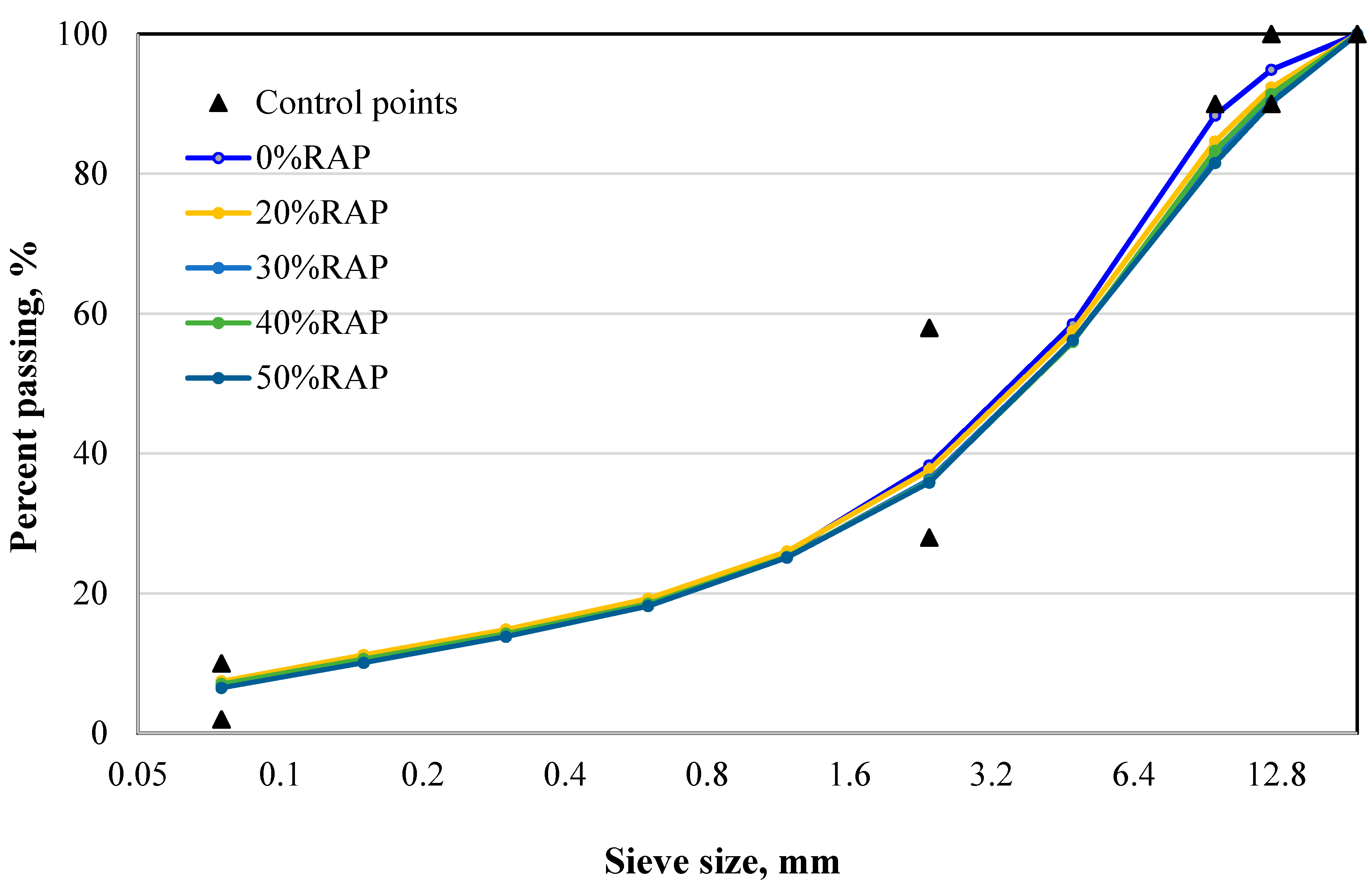
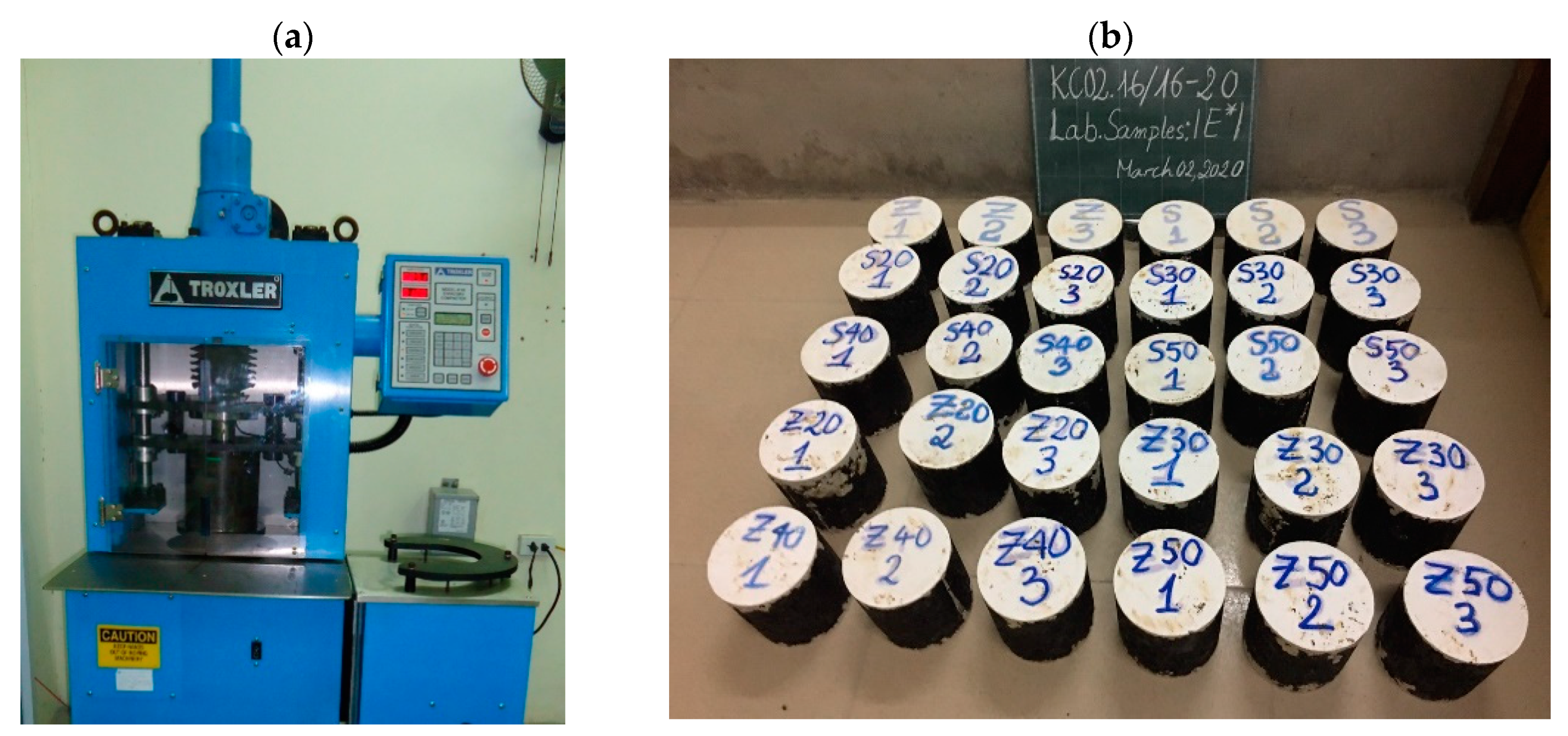
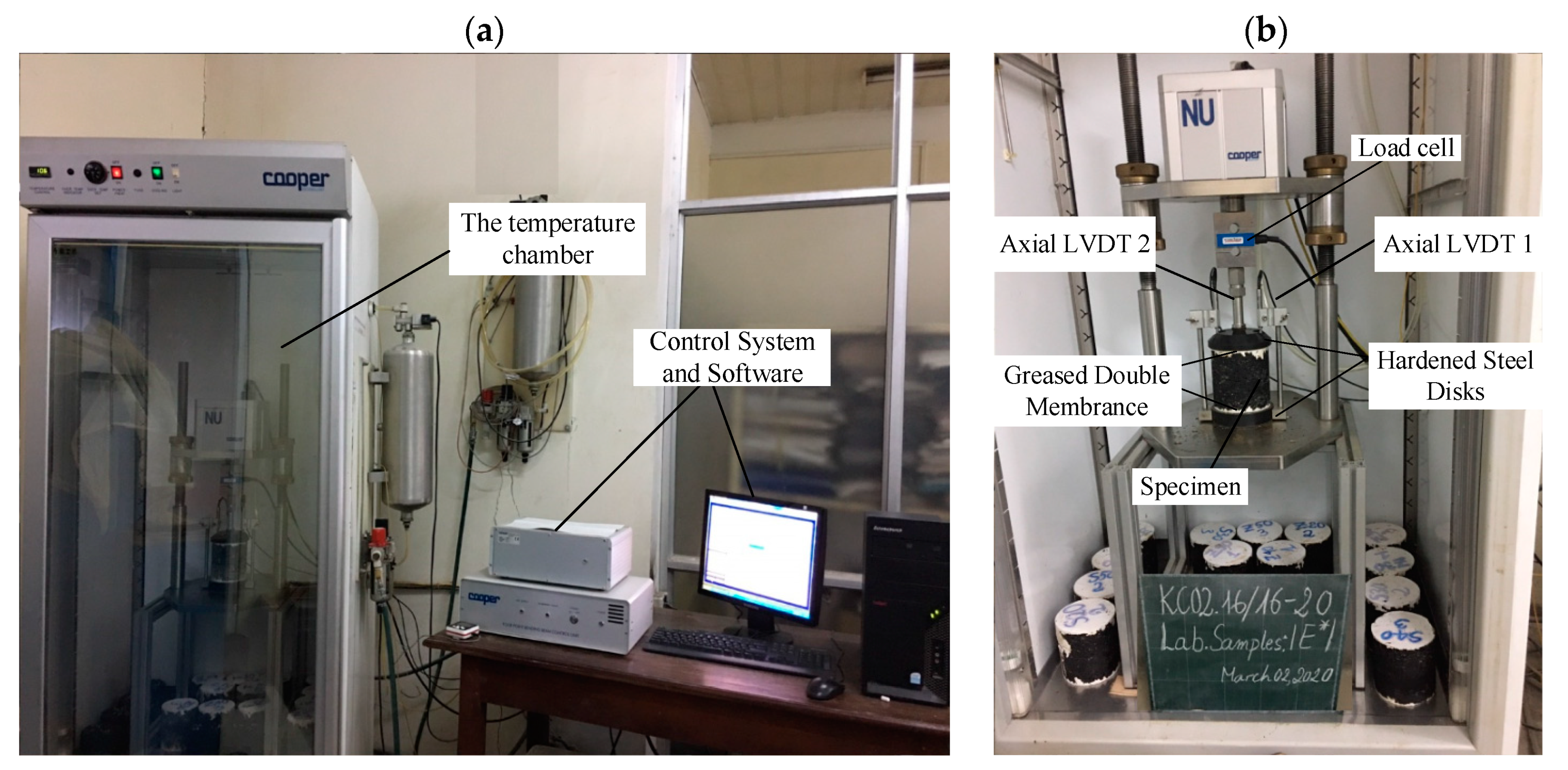
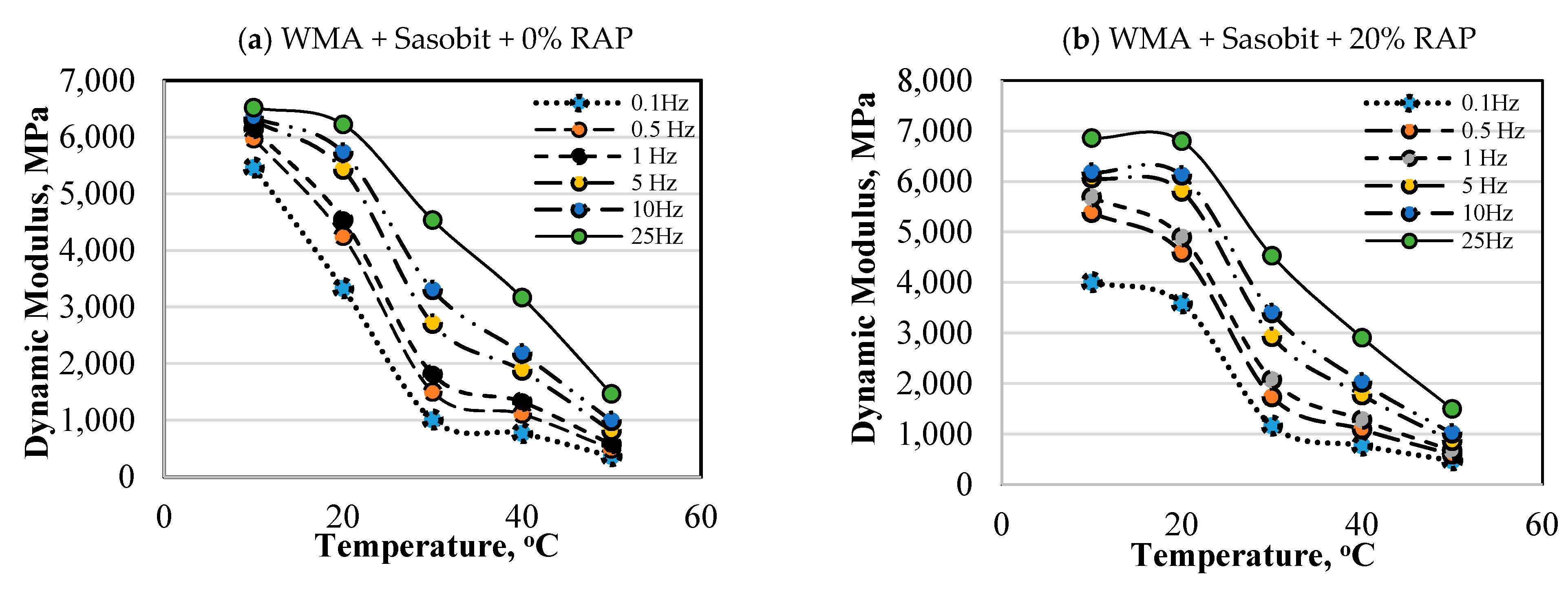
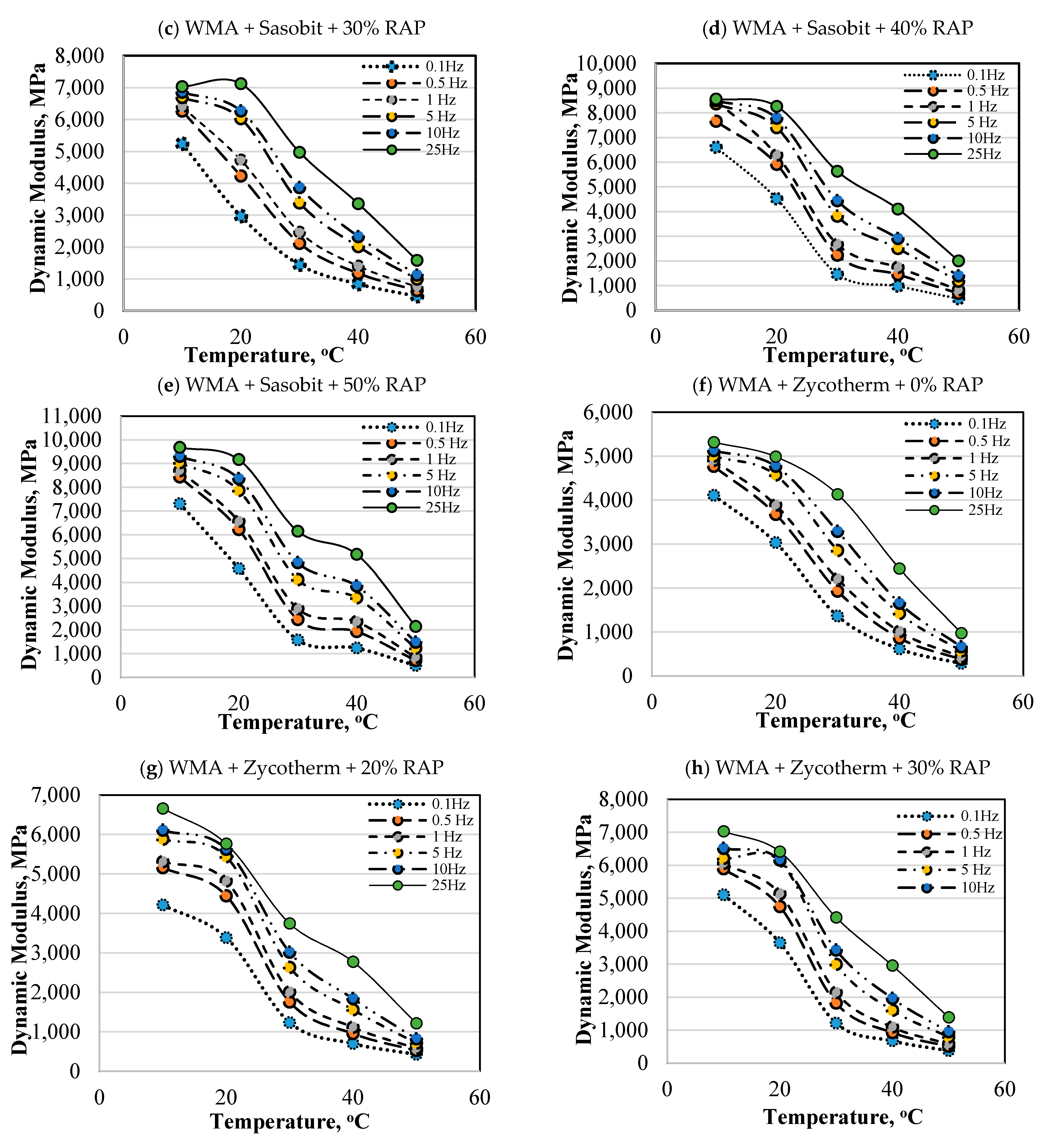
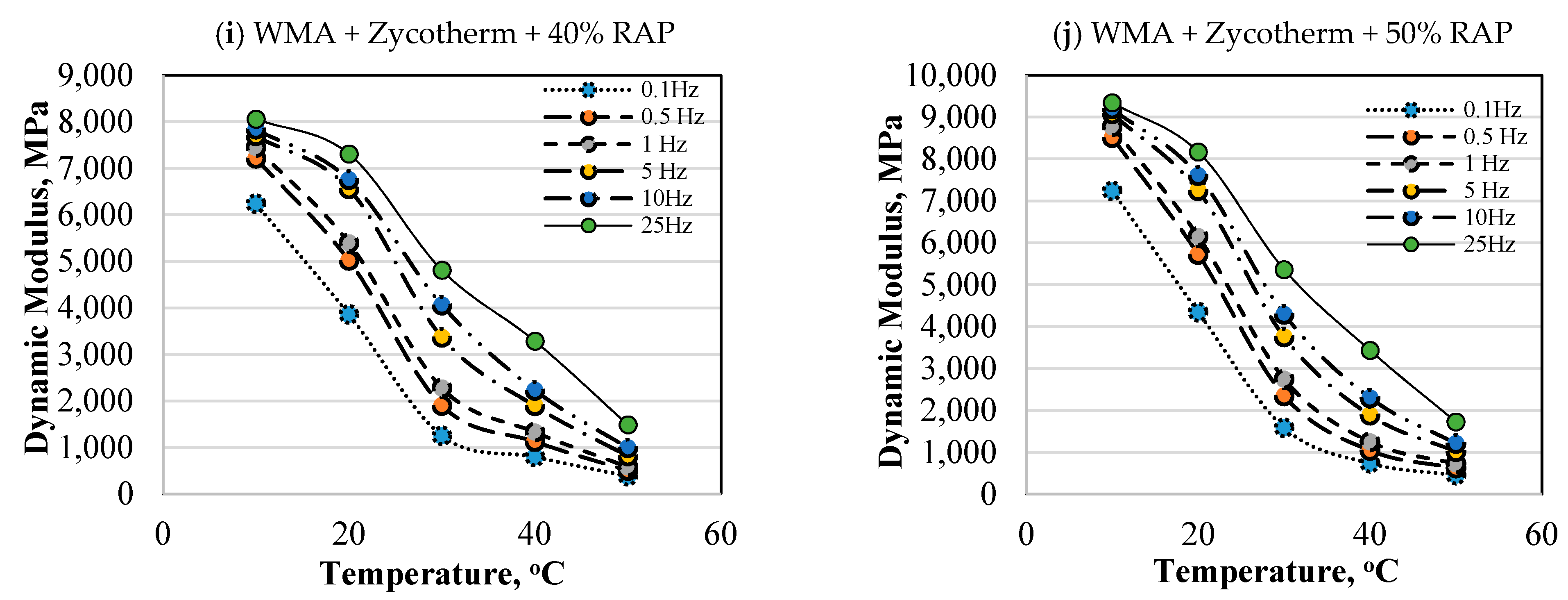
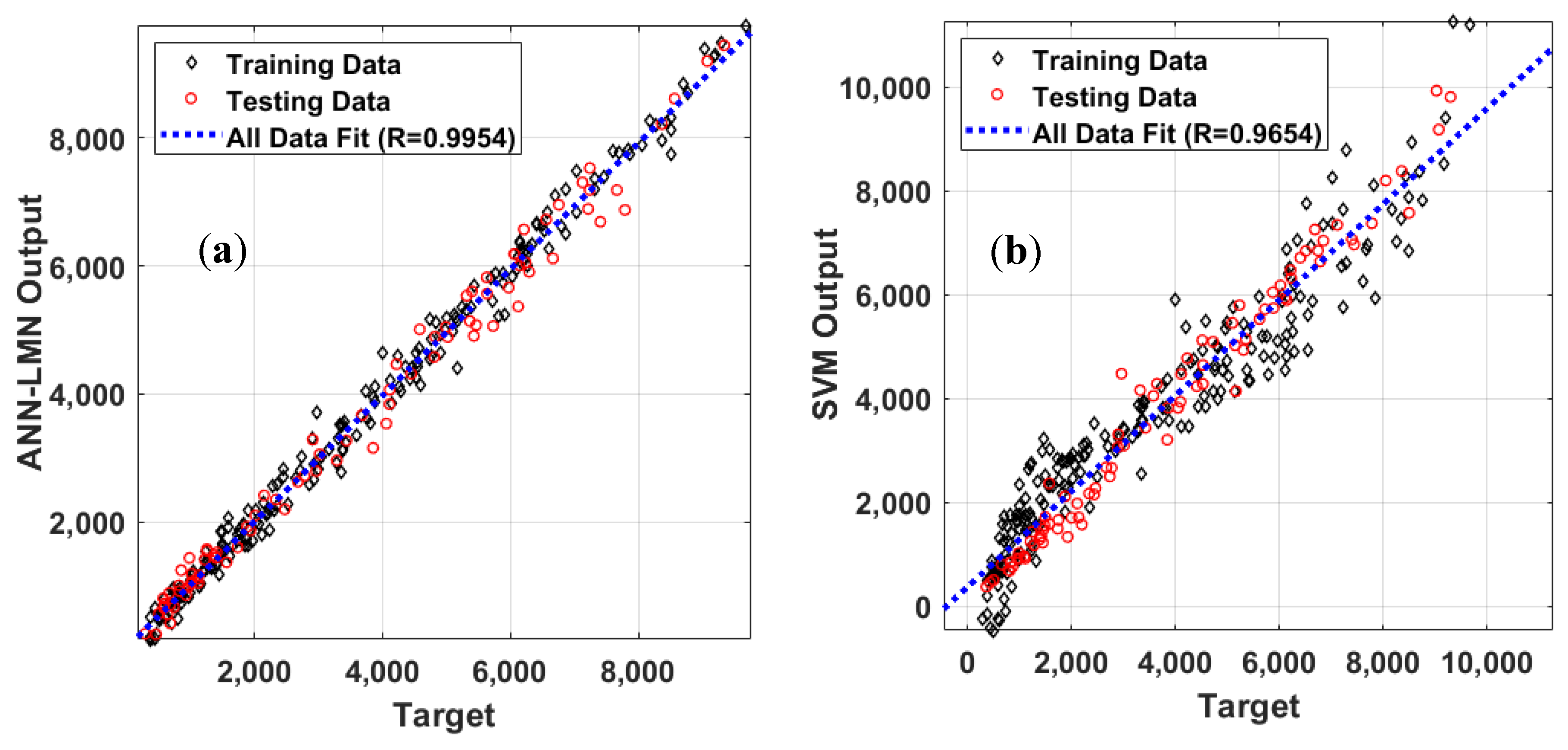
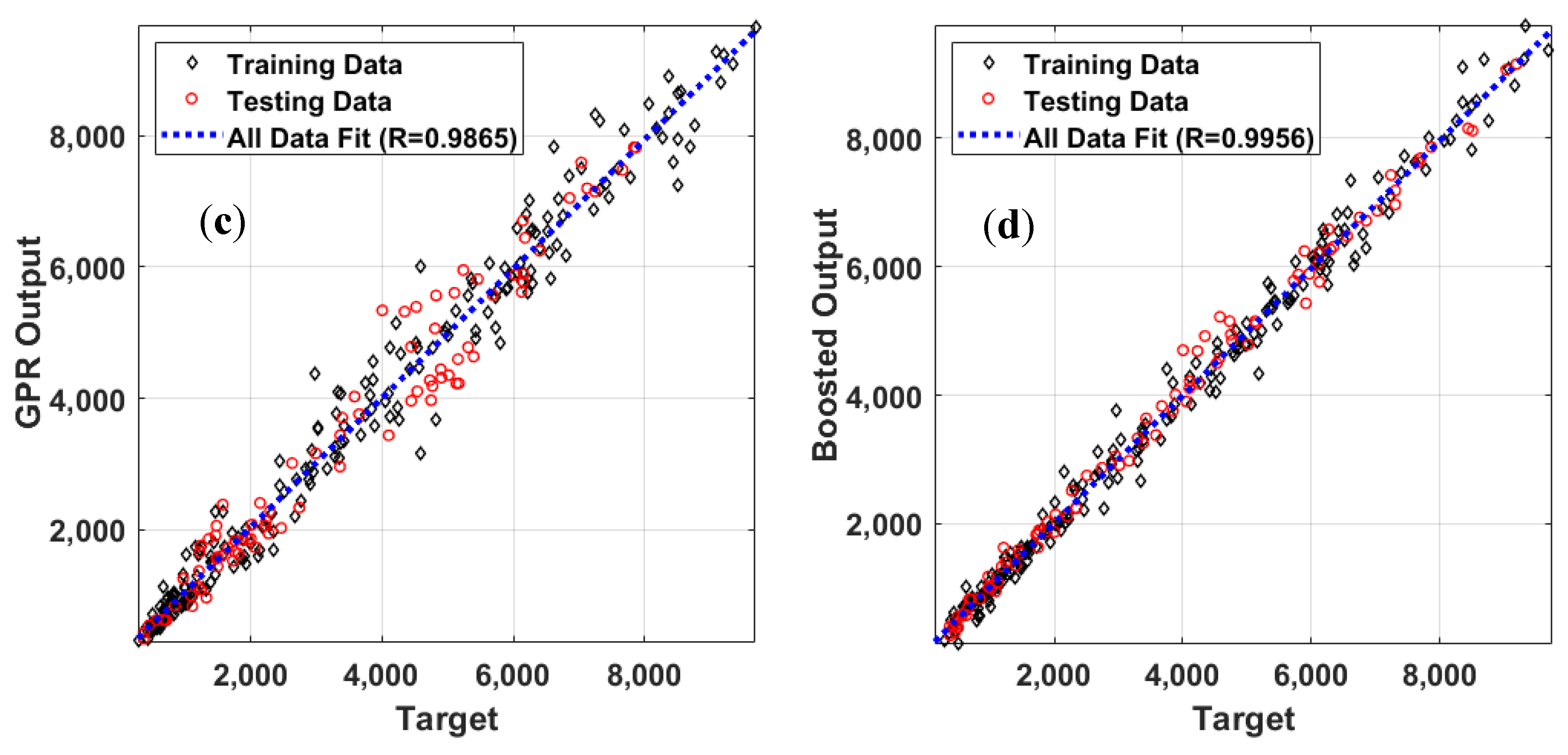
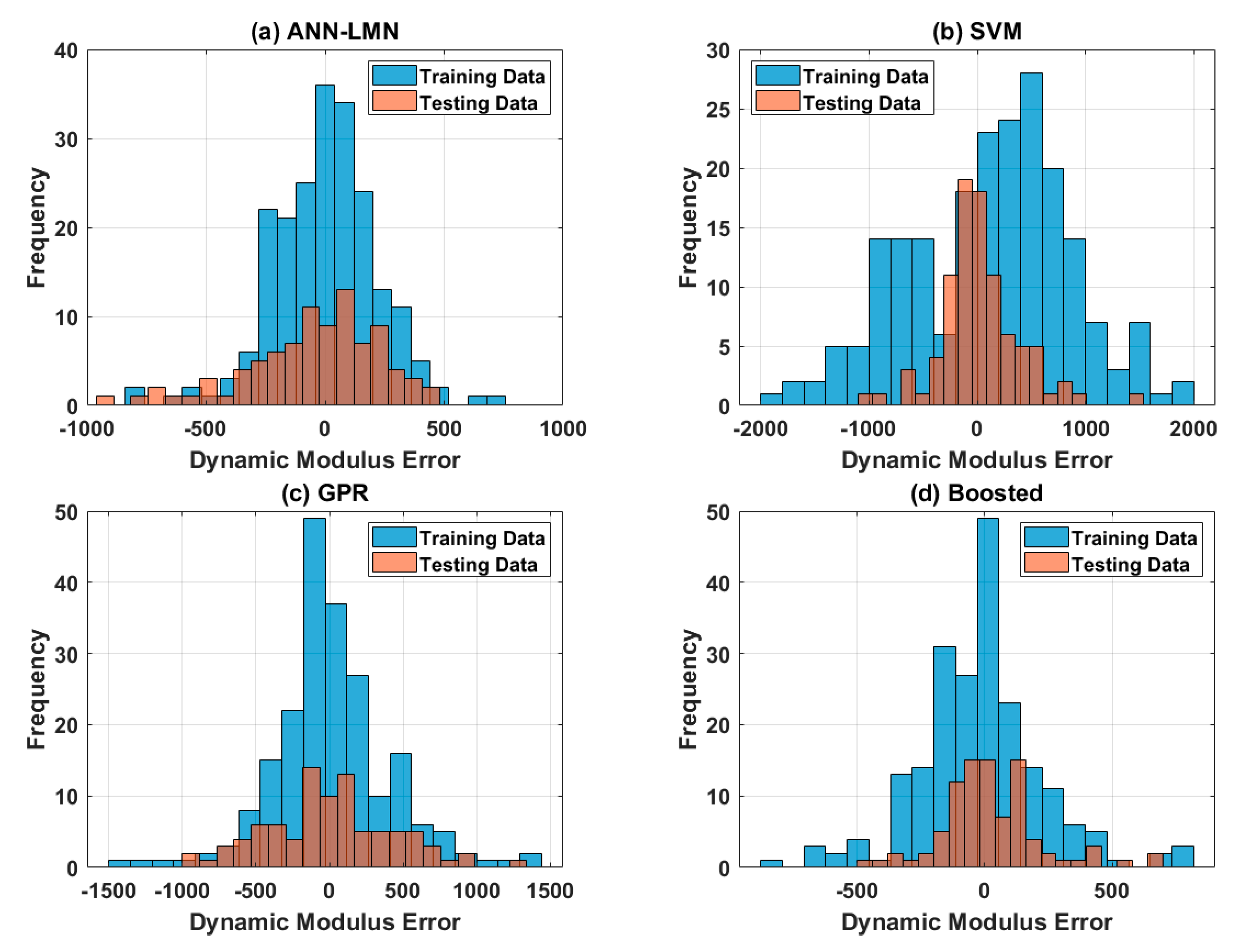
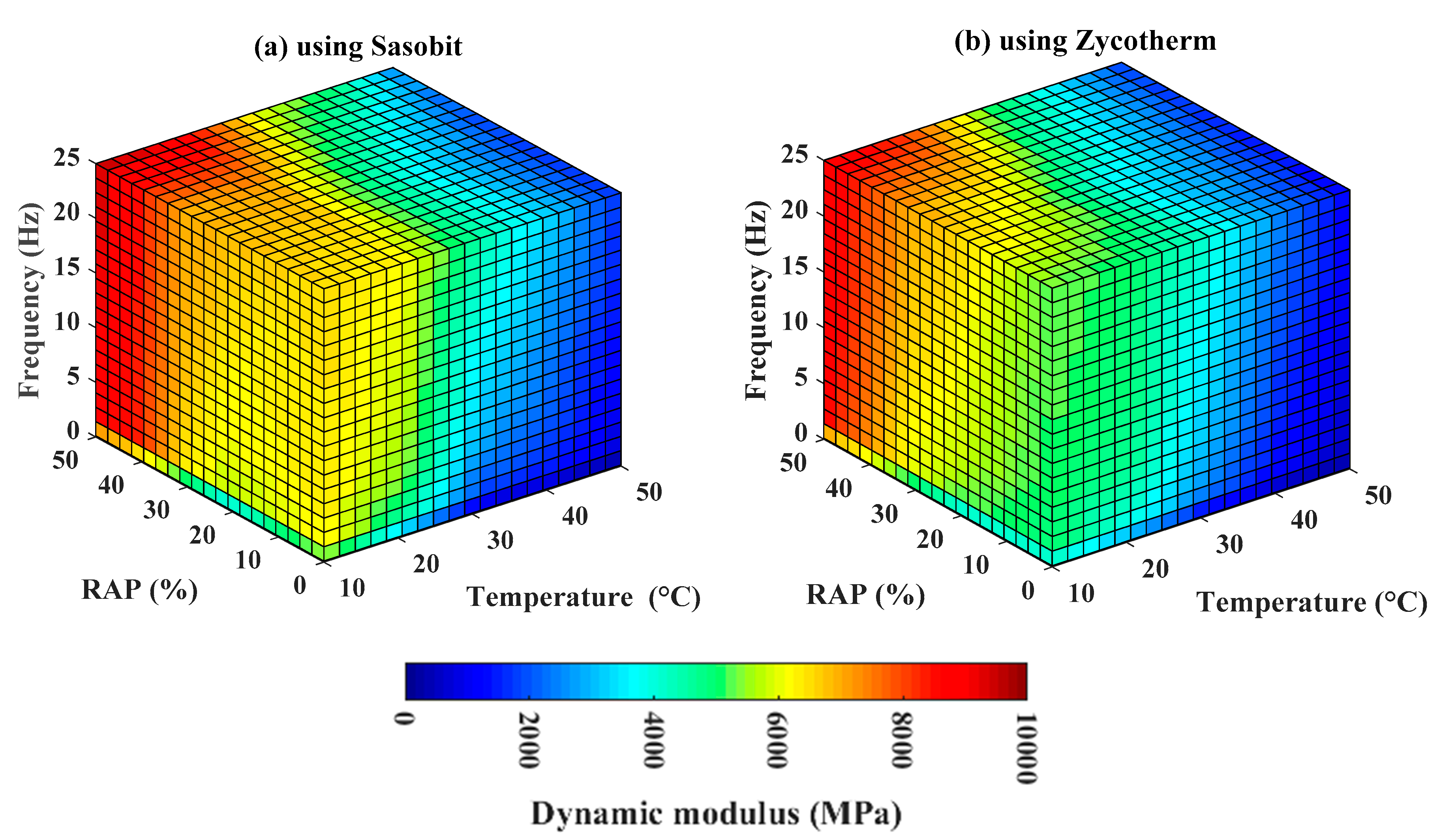
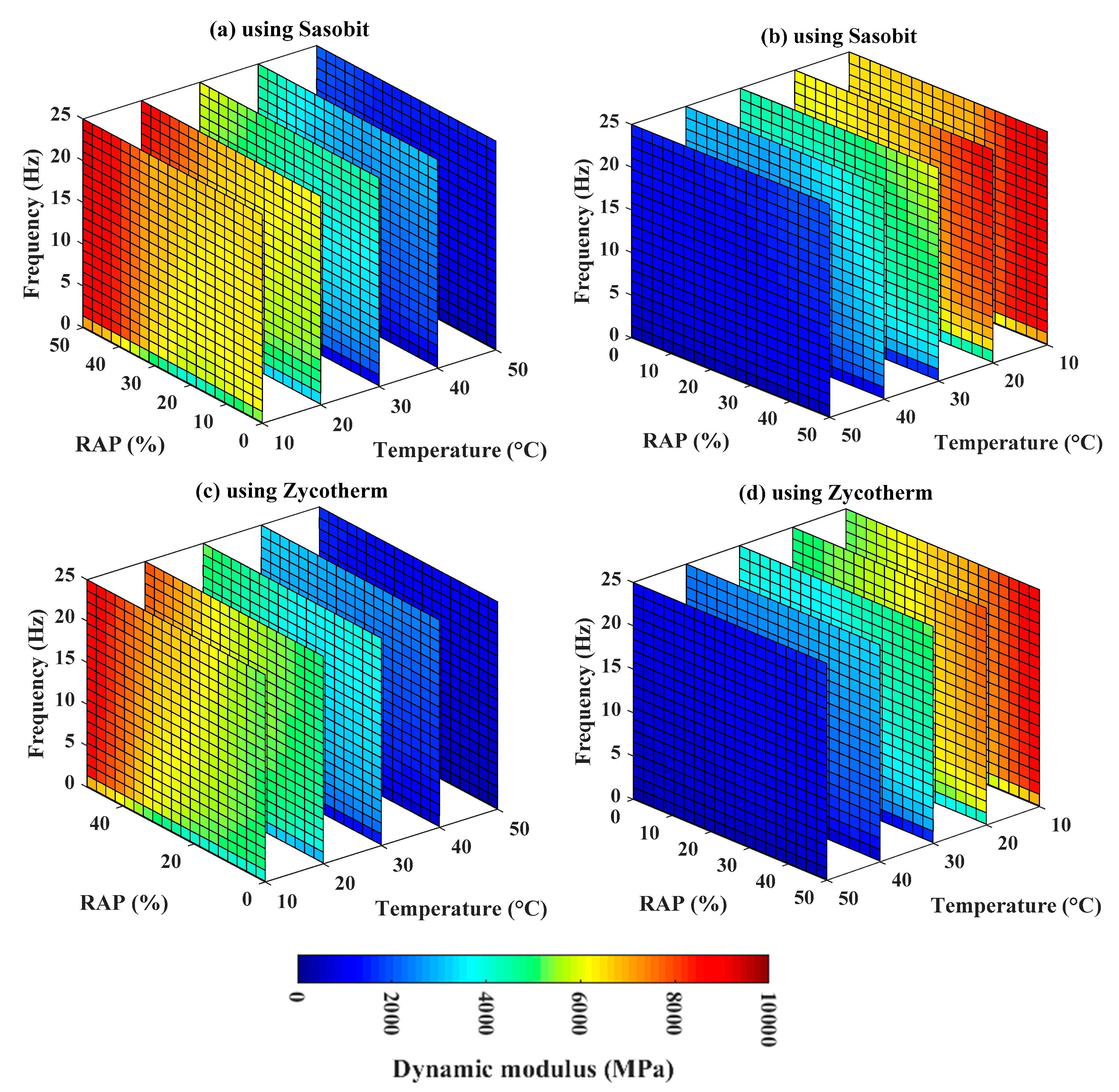
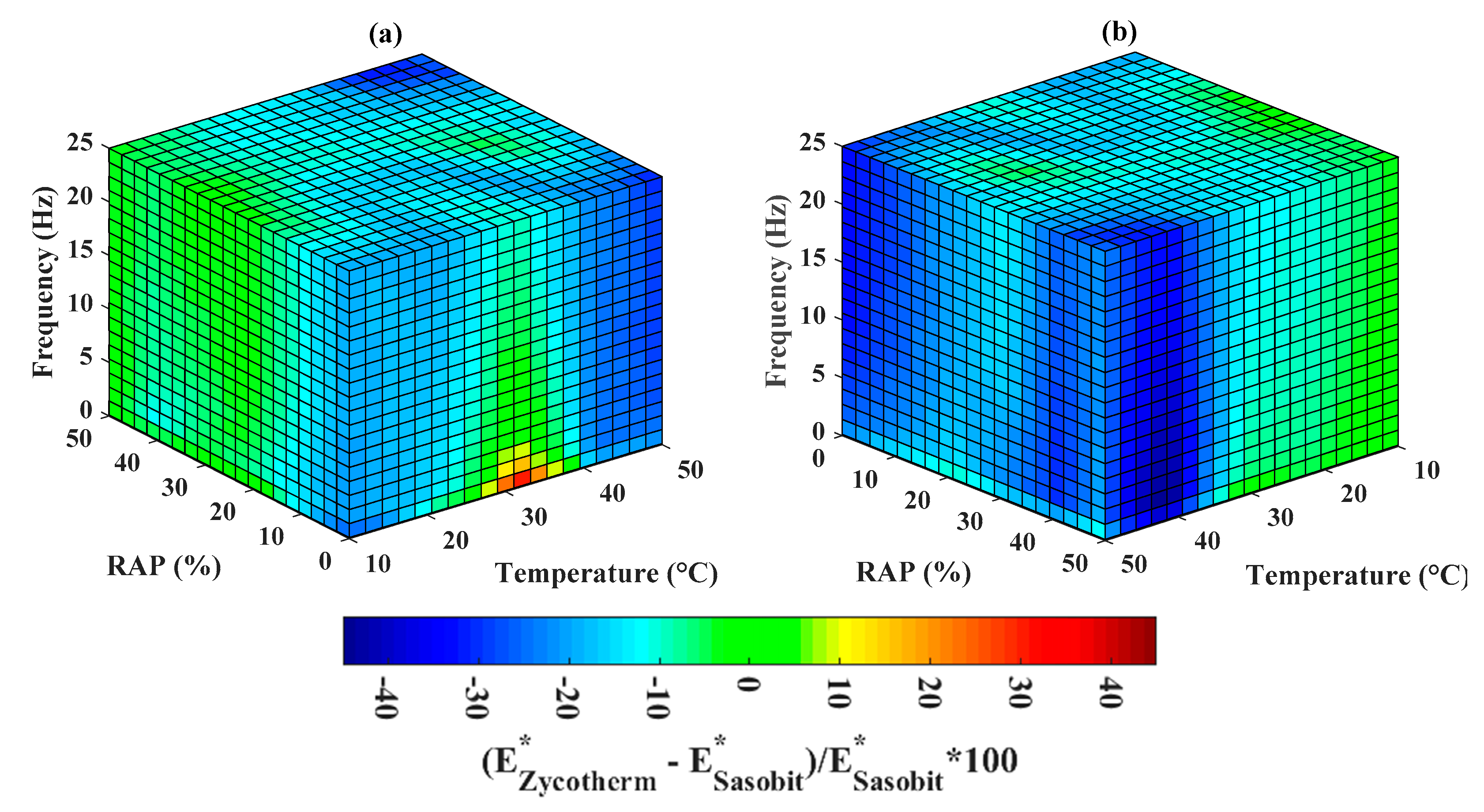
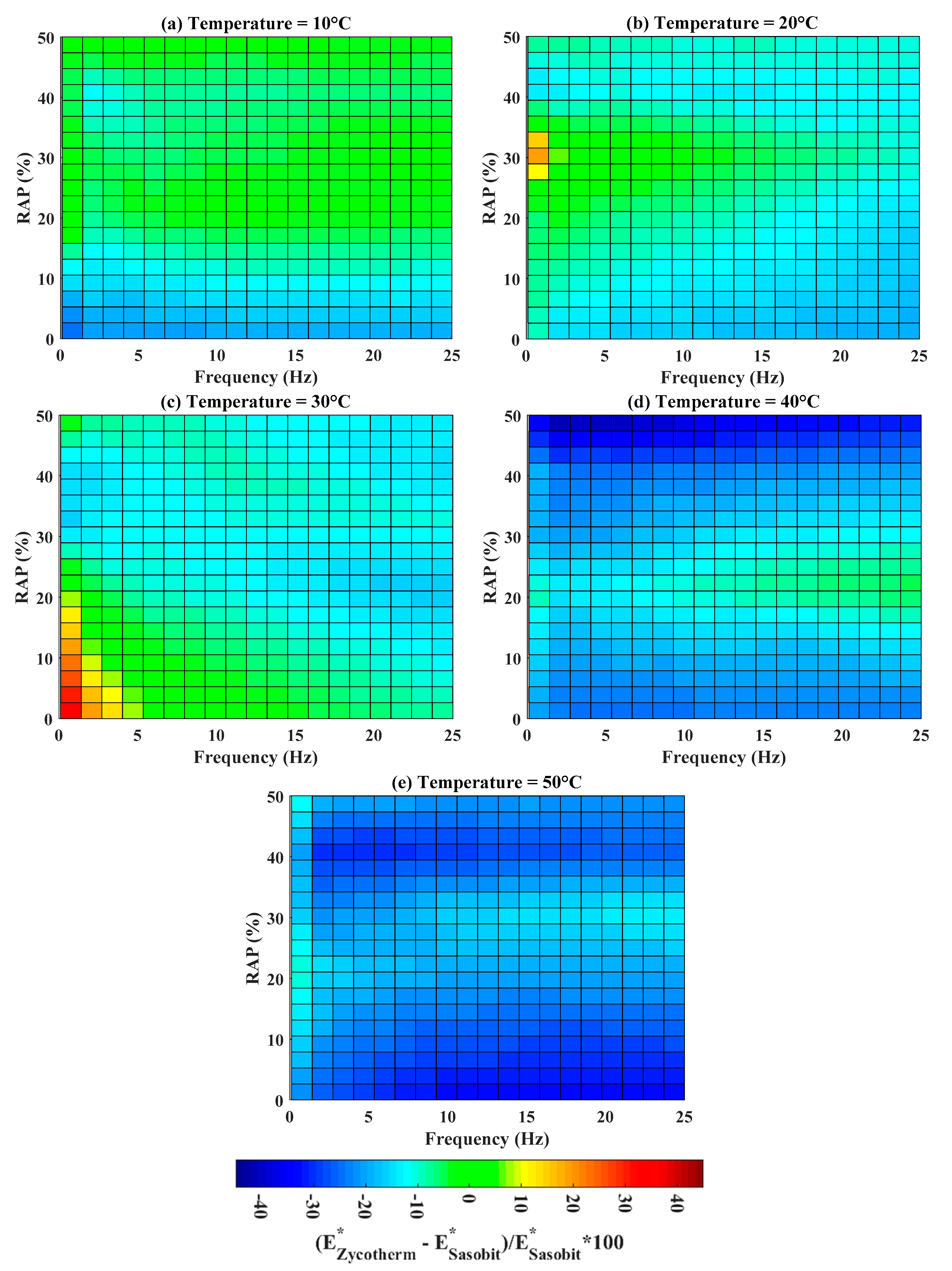
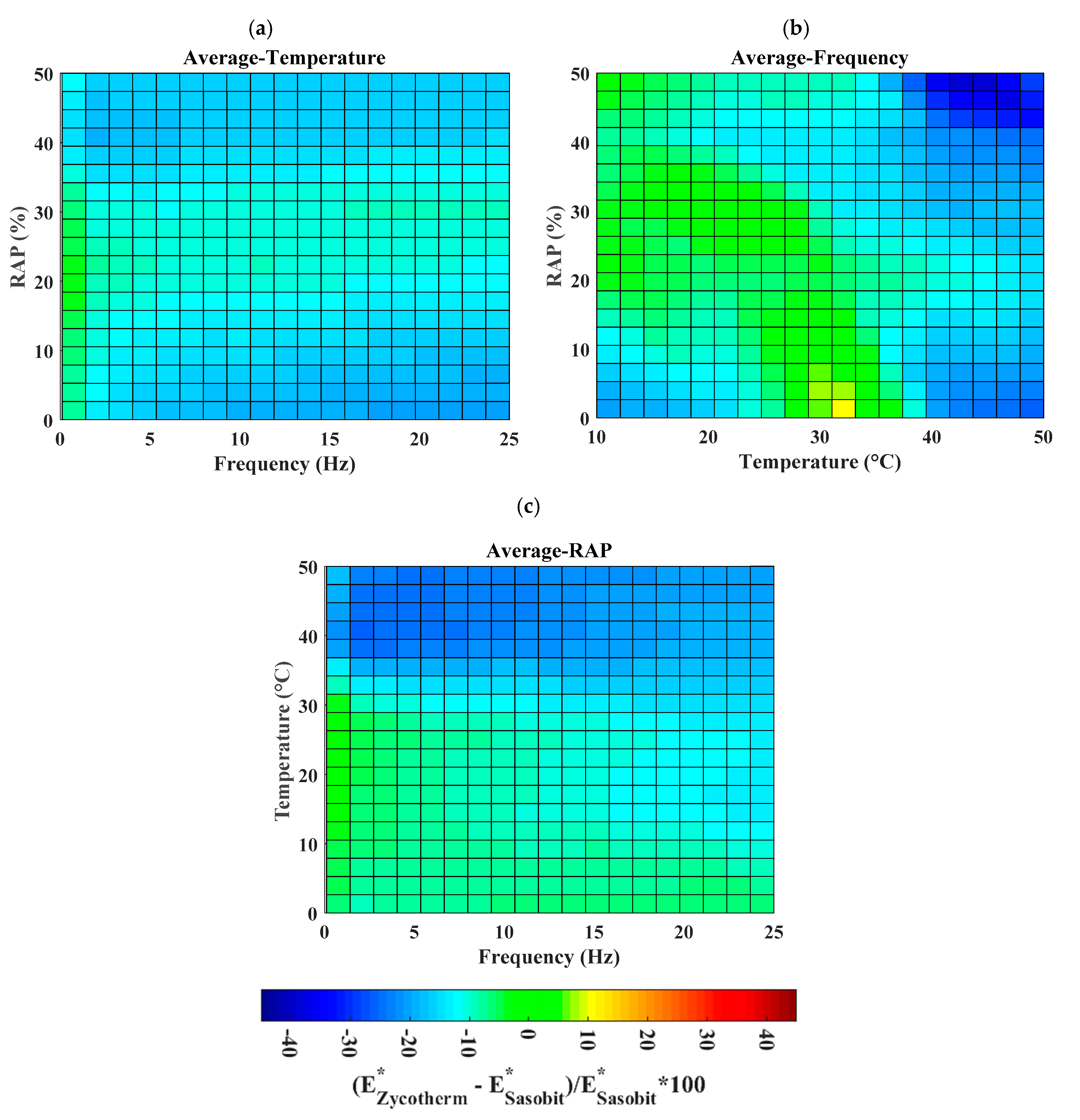
| Properties | Agg.12.5 | Agg.9.5 | Agg.9.5 | Filler | Specification |
|---|---|---|---|---|---|
| Bulk Specific Gravity (Gsb) | 2.735 | 2.725 | 2.702 | 2.712 | AASHTO T84, 85 |
| App.Specific Gravity (Gsa) | 2.751 | 2.752 | 2.740 | - | AASHTO T84, 85 |
| Absorption, % | 0.207 | 0.365 | 0.517 | - | AASHTO T84, 85 |
| Clay and dust content, % | 0.35 | 0.67 | - | - | ASTM C142 |
| Flat and elongation, % | 11.26 | 8.41 | - | - | ASTM D4791 |
| Fineness modulus | - | - | 3.48 | - | ASTM C33 |
| Los Angeles, % | 23.48 | - | - | - | ASTM C131 |
| Sand equivalent value | - | - | 73.9 | - | AASHTO T176 |
| Plasticity index | - | - | - | 1.09 | ASTM D4318 |
| Condition | Properties | Bitumen 60/70 (Virgin) | Bitumen 60/70 with Sasobit | Bitumen 60/70 with Zycotherm | Specification |
|---|---|---|---|---|---|
| Unaged | Penetration at 25 °C, 0.1 mm | 66 | 52 | 64 | ASTM D 5 |
| Flash point, °C | 253 | 247 | 259 | ASTM D 92 | |
| Softening point, °C | 49.5 | 69.8 | 50.7 | ASTM D 36 | |
| Ductility at 25 °C, cm | >100 | >100 | >100 | ASTM D 113 | |
| Rotational Viscometer, Pa.s | 0.385 | 0.237 | 0.316 | AASHTO T316 | |
| G*/sinδ at 64 °C, kPa | 1.15 | 2.96 | 1.06 | AASHTO T315 | |
| Short-term aged (RTFO) | G*/sinδ at 70 °C, kPa | 2.62 | 6.497 | 3.439 |
| Properties | Value | Specification |
|---|---|---|
| Penetration at 25 °C, 0.1 mm | 25.4 | ASTM D 5 |
| The softening point, °C | 76.7 | ASTM D 36 |
| Viscosity at 135 °C, Pa.s | 2.134 | AASHTO T316 |
| G*/sinδ at 82 °C, kPa | 1.1 | AASHTO T315 |
| WMA with RAP + Zycotherm | WMA with RAP + Sasobit | |||||||||
|---|---|---|---|---|---|---|---|---|---|---|
| Mix Composition/Mix Content | ||||||||||
| RAP | 0 | 19.0 | 28.5 | 37.9 | 47.4 | 0.0 | 19.0 | 28.5 | 37.9 | 47.4 |
| Agg.12.5 | 19.2 | 9.5 | 9.5 | 6.6 | 6.6 | 19.2 | 9.5 | 9.5 | 6.6 | 6.6 |
| Agg.9.5 | 28.8 | 20.0 | 16.1 | 14.2 | 8.5 | 28.8 | 20.0 | 16.1 | 14.2 | 8.5 |
| Agg.4.75 | 43.2 | 42.8 | 38.0 | 33.2 | 30.3 | 43.2 | 42.8 | 38.0 | 33.2 | 30.3 |
| Filler | 3.8 | 3.8 | 2.8 | 2.8 | 1.9 | 3.8 | 3.8 | 2.8 | 2.8 | 1.9 |
| Pb(RAP) | 0.0 | 0.8 | 1.1 | 1.5 | 1.9 | 0.0 | 0.8 | 1.1 | 1.5 | 1.9 |
| Pbn | 5.0 | 4.2 | 4.0 | 3.7 | 3.4 | 5.0 | 4.2 | 4.0 | 3.7 | 3.4 |
| Total | 100 | 100 | 100 | 100 | 100 | 100 | 100 | 100 | 100 | 100 |
| Properties of Mixtures | ||||||||||
| Va (%) | 4.5 | 3.9 | 4.1 | 4.1 | 4.3 | 3.9 | 4.0 | 4.1 | 3.8 | 4.1 |
| VMA (%) | 15.7 | 14.1 | 14.1 | 14.3 | 14.3 | 14.3 | 14.5 | 14.3 | 14.1 | 14.1 |
| VFA (%) | 71.5 | 72.1 | 70.7 | 70.9 | 70.1 | 72.4 | 71.0 | 71.0 | 71.4 | 70.6 |
| Pba (%) | 0.3 | 0.72 | 0.70 | 0.95 | 1.05 | 0.44 | 0.72 | 1.04 | 1.22 | 1.48 |
| Pbe (%) | 4.7 | 4.32 | 4.44 | 4.30 | 4.31 | 4.58 | 4.32 | 4.11 | 4.04 | 3.90 |
| P0.075/Pbe | 0.8 | 0.85 | 0.83 | 0.86 | 0.86 | 0.81 | 0.00 | 0.90 | 0.91 | 0.95 |
| MS (kN) | 11.3 | 13.83 | 15.03 | 16.06 | 16.64 | 13.45 | 14.97 | 16.37 | 18.11 | 19.10 |
| MF (mm) | 3.5 | 3.62 | 3.58 | 3.58 | 3.56 | 3.27 | 3.62 | 3.58 | 3.56 | 3.61 |
| Dataset | Criterion | ANN-LMN | SVM | GPR | Boosted |
|---|---|---|---|---|---|
| Training | RMSE | 225.99 | 758.50 | 408.74 | 248.54 |
| MAE | 171.81 | 623.10 | 292.05 | 179.82 | |
| R | 0.9959 | 0.9565 | 0.9880 | 0.9953 | |
| Testing | RMSE | 283.38 | 376.29 | 432.82 | 203.84 |
| MAE | 215.15 | 265.50 | 333.68 | 144.68 | |
| R | 0.9944 | 0.9989 | 0.9819 | 0.9967 | |
| All | RMSE | 244.63 | 667.23 | 416.11 | 236.02 |
| MAE | 184.82 | 515.82 | 304.54 | 169.28 | |
| R | 0.9954 | 0.9654 | 0.9865 | 0.9956 |
© 2020 by the authors. Licensee MDPI, Basel, Switzerland. This article is an open access article distributed under the terms and conditions of the Creative Commons Attribution (CC BY) license (http://creativecommons.org/licenses/by/4.0/).
Share and Cite
Dao, D.V.; Nguyen, N.-L.; Ly, H.-B.; Pham, B.T.; Le, T.-T. Cost-Effective Approaches Based on Machine Learning to Predict Dynamic Modulus of Warm Mix Asphalt with High Reclaimed Asphalt Pavement. Materials 2020, 13, 3272. https://doi.org/10.3390/ma13153272
Dao DV, Nguyen N-L, Ly H-B, Pham BT, Le T-T. Cost-Effective Approaches Based on Machine Learning to Predict Dynamic Modulus of Warm Mix Asphalt with High Reclaimed Asphalt Pavement. Materials. 2020; 13(15):3272. https://doi.org/10.3390/ma13153272
Chicago/Turabian StyleDao, Dong Van, Ngoc-Lan Nguyen, Hai-Bang Ly, Binh Thai Pham, and Tien-Thinh Le. 2020. "Cost-Effective Approaches Based on Machine Learning to Predict Dynamic Modulus of Warm Mix Asphalt with High Reclaimed Asphalt Pavement" Materials 13, no. 15: 3272. https://doi.org/10.3390/ma13153272
APA StyleDao, D. V., Nguyen, N.-L., Ly, H.-B., Pham, B. T., & Le, T.-T. (2020). Cost-Effective Approaches Based on Machine Learning to Predict Dynamic Modulus of Warm Mix Asphalt with High Reclaimed Asphalt Pavement. Materials, 13(15), 3272. https://doi.org/10.3390/ma13153272








